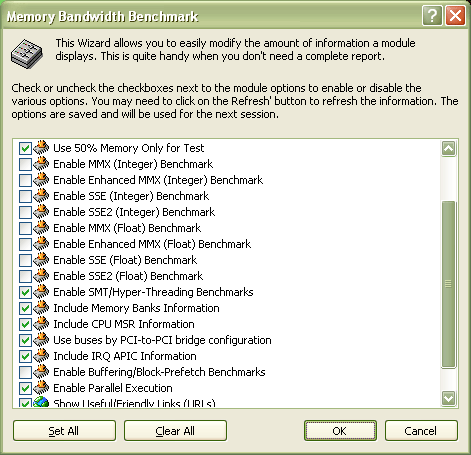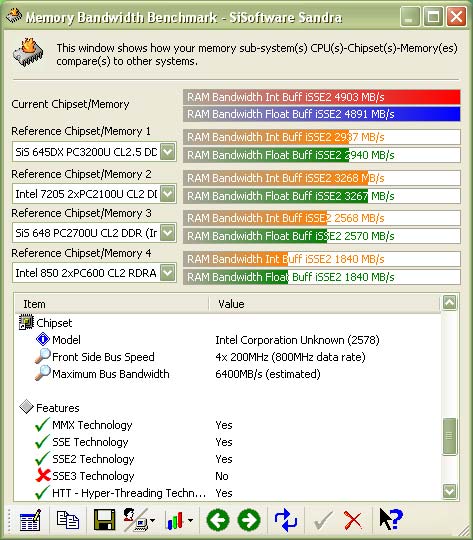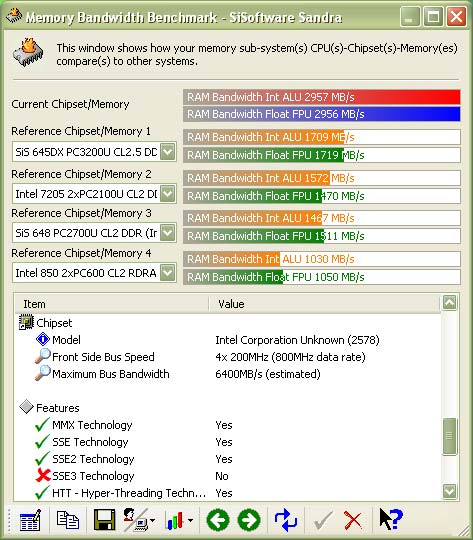Searching for the Memory Holy Grail: Part 1
by Wesley Fink on July 27, 2003 11:13 PM EST- Posted in
- Memory
Test Design
AnandTech has had reservations about the usefulness of synthetic benchmarks to measure the performance of computers. However, testing memory is one area where it is hard to avoid synthetic benchmarks. We were particularly concerned about some of the memory benchmarks we have seen posted with the 875/865 chipset boards. Some of the more widely-used synthetic benchmarks are being used to “demonstrate” performance that we logically know – based on Intel 865/865 chipsets white papers – to be not the case.
MemTest86
MemTest86 has been around for many years, and it is the standard in Memory Testing for many computer enthusiasts. The program boots from CD-ROM or floppy using its own DOS-like operating system, and tests memory at its most basic level. To many enthusiasts, this program is the ultimate test to determine the stability of memory. If you wonder why we would use such an ancient benchmark, it is because we have not found anything that is really better to test memory performance and stability. Apparently, we are not alone, since MemTest86 is still widely used in the Memory industry to test the stability of memory modules.
As a baseline, MemTest86 was run on an 875 Canterwood system with a Pentium 4 3.0GHz CPU and 2x512MB double-sided high-speed DIMMs at timings of 2,5,2,2. This gives us a MemTest86 score at Default Settings of 2,722MB/sec.
More information on MemTest86 is available at their site. Floppy and ISO versions of the program are also available at this site for download.
UNBuffered Memory Performance in Windows XP
In search of a reliable memory benchmark, we find that SiSoft Sandra 2003 is one of the more widely used memory benchmarks. Looking closer, we did not feel the standard Sandra memory test, which relies heavily on synthetic memory buffering techniques, provided the kind of sensitivity we needed for these tests. It is true that Sandra uses the same buffering techniques as in the CPU and chipset tests, but these buffering techniques themselves can often mask poor memory performance and sometimes provide memory performance scores that do not correlate well with real-world performance.
While we don’t know exactly where it started, we have seen a number of enthusiast sites using a variation of the Sandra Memory, which turns off buffering techniques and comes closer to measuring raw memory performance. Macci was one of the first to use the UNBuffered benchmark – the famous Finn who is always at or near the top of the 3DMark scores. In addition, Tony Leach in England and I have used it in many reviews on other web sites.
The idea of the UNBuffered Memory Benchmark is very simple – you merely turn off all memory buffering techniques. Sandra makes this very easy to do. Select ‘Memory Benchmark’, right-click ‘Module Options’, and uncheck the 9 boxes that have to do with buffering.

The UNBuffered Memory Benchmarks are quite different from what you may be accustomed to seeing. As an example, these are Buffered or Standard Memory benchmarks with two double-sided DIMMs on a 875 Canterwood board at stock 3.0GHz at DDR400 at memory timings of 2-5-2-2.

Using the same settings for the UNBuffered Memory Benchmark (3.0GHz, DDR400, 2-5-2-2, 2x512MB DIMMs), we achieved much lower numbers.

Please look carefully at the screen captures above, and notice that THE MEMORY BAR STATES “BUFF” IN THE DESRIPTION ON A STANDARD TEST. “BUFF” IS NOT USED IN THE DESCRIPTION IN THE UNBUFFERED MEMORY TEST
While the score of the UNBuffered benchmark is much lower than the standard Memory Test, the UNBuffered benchmarks are very comparable to MemTest86 results. This excellent correlation of MemTest86 and SiSoft Sandra UNBuffered Memory Test results seems to be true in most situations. Benchmarks are only useful in the end in how they can compare different configurations and hardware. We have found standard Dual-Channel DDR400 Performance on Intel 875/865 chipset motherboards, as you see above, in the 2300 to 3000 MB/sec range as measured with the Sandra UNBuffered Memory Benchmark. MemTest86 gives similar results.
We will post a few more sets of Buffered (Standard) and UNBuffered Sandra 2003 benchmarks in this review to demonstrate the validity of the UNBuffered benchmark as a Memory Performance testing tool, and then use only UNBuffered benchmarks for the rest of the review.










42 Comments
View All Comments
jsalpha2 - Tuesday, July 29, 2003 - link
Pardon me, cause I'm tired. Did the article say if 4x(256) is better or worse than 2x(512). Assuming identicle brand and speed of RAM.I think I heard somewhere to go with just two sticks for better performance. Plus then you have open slots for later.
Question #2 Would 2x(512) of cheaper DDR333 be better than 2x(256) of DDR400?
thanks
Anonymous User - Tuesday, July 29, 2003 - link
Great article, it's just missing latency benchmarks.Anonymous User - Tuesday, July 29, 2003 - link
Ok - pardon the newbie question, but - I'm building a P4c with Asus P4P800 board. I want 1 gig of DDR400 ram - what brand/model number do I buy - ?Thanks for your help.
Anonymous User - Tuesday, July 29, 2003 - link
This is all nice and good, but what does it all mean in the real world, run some benchmarks in these various modes and show us whether we should care about it :) bottom line to me is what it does for the games, if i'm losing/gaining 4 FPS i'm more likely to care about the price differences then memtest.Wesley Fink - Tuesday, July 29, 2003 - link
These are quoted form Intel's White Paper, p.13 "NOTES: Ranks per Dimm (1 Rank is a single-sided DIMM, 2 Ranks is a double-sided DIMM)". The common practice of using higher-density Dimms every other Dimm on both sides (4 chips per side) is FUNCTIONALLY a Single Bank or Single-Sided Dimm.As for confirming that 4 dimms was faster, only the tests on the 3.0 were CPU-limited. We also determined maximum overclock on a 2.4C which was not CPU-Limited. Please check Page 7.
Philippine Mango - Thursday, January 25, 2007 - link
Wrong, you didn't use a 2.4C, you used a 2.6 processor which from what I know doesn't overclock as well as the 2.8C or 2.4C..Anonymous User - Tuesday, July 29, 2003 - link
"...we confirmed that the added memory bandwidth more than makes up for the slightly lower overclock with four double-sided DIMMs"To say you 'confirmed it' is quite a leap indeed... as you notably stated, you were CPU limited in going any higher for 1 and 2 sticks, whereas you clearly reached a blockade with the 4 sticks of memory. It could be that 4 sticks of memory causes a blockade in the chipset performance at some GHz, but with a better CPU you might have gone much higher with the opposing configurations.
-Robert
Anonymous User - Tuesday, July 29, 2003 - link
"If you plan to run DDR400 as your base memory speed with an 800FSB processor, your best memory performance will clearly be with four matched double-sided DIMMs"Can somebody help me to understand this?
I have only heard about 2 matched DIMMs...
Four matched DIMMs is 2 X 2 matched DIMMS?
Thank you very much!
Anonymous User - Tuesday, July 29, 2003 - link
While the article was interesting in that it at least confirmed Intel's white paper, I would be interested in your also testing ECC. I have a machine which does double duty as a backup server (plug the disks in the SCSI port and away it goes!). I am just curious as to the performamce hit when ECC is being used.Anonymous User - Tuesday, July 29, 2003 - link
The writer does not distinguish between DS and double bank module ;)